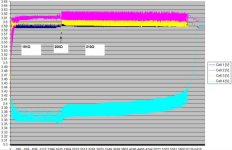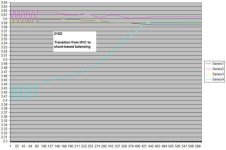GGoodrum said:
It's coming, but we ran into a couple of issues, mainly with the HVC triggering and interaction with the charge controller logic, as it applies to PSI LiFePO4 cells. Andy discovered the problem, and I'm in the process of duplicating his test setup, so that I can see what is happening.
Yes - there is a problem with the HVC detector portion. Unfortunately, while it properly recognizes the ~3.7V point on the bench with no cells attached, it does not work with cells attached. While it's true that my main test pack is PSI cells, the malfunction is the same regardless of the cell manufacturer. With cells attached, the HVC doesn't trip even when cell voltages rise to 4.2V. If the resistor divider is adjusted to bring the trip point lower, the HVC activates immediately at 3.6V as soon as the shunt activates (instead of when the shunt is at maximum current).
GGoodrum said:
Also, he managed to get the relay-based charge controller to get stuck with the relay latched in the wrong position.
Oy. I "managed" to get the relay-based charge controller to get stuck by simply using the BMS as it was intended. The device works perfectly with a balanced pack. Unfortunately, if the pack's always balanced, there's not much need for a BMS...

With an unbalanced pack, and with the HVC activating as soon as the shunt activates, the relay trips and then releases. It will do this for just under 43 minutes.
*** At this point, the charge controller LED goes green, the relay latches 'on', and the charger pushes current into the pack unchecked until the shunts are swamped. That's when things get really hot, solder flows, and cells are destroyed. Hell, I can do that with a pack without spending the time and money to build a BMS.

In addition, I'm not happy with the way the charge controller operates. It requires a 'start' button press at the beginning of the charge, but the relay immediately closes even with no 'start' button press. This means that the pack is getting fed from the charger immediately, but the HVC sensing electronics are not yet 'on line' and cannot protect the pack. To make it more challenging, I was unable to activate the charge controller with the start button if a cell is already too high and the shunt is activated - the HVC keeps the controller from starting normally. This would be great if the relay didn't automatically close, but as it is, this is yet another condition where the pack cannot be protected from overcharge. And it makes it impossible to use this device to balance an out of balance pack.
Step away from the stage - there's no fat lady warming up yet...
edit...
*** It appears that the controller didn't fail after 43 minutes, but the opto for the high cell failed. I don't have enough information to blame either the opto or the circuit as channel 4 failed - and this channel has been the guinea pig for all the resistor changes and other fiddling.



